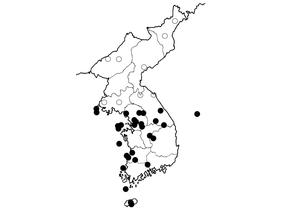You are here
Dicots
Ampelopsis heterophylla (Thunb.) Siebold & Zucc.
Primary tabs
Nomenclature
-
Family: VitaceaeGenus: Ampelopsis
SUMMARY
낙엽 덩굴성. 길게 벋으며 가지에 털이 없다. 수피는 갈색, 마디가 굵다. 겨울눈 및 소지 은아로 보기 어렵다. 잎자국은 반원형이다. 잎 어긋나기, 둥글며 점처두, 아심장저, 3-5개로 갈라진다. 크기는 4.5-7(13)cm × 4.5-8(11)cm 각열편에 둔한 치아상의 톱니가있고, 표면에 털이 없으며 뒷면 맥 위에 잔털이 있다. 잎자루 길이 2-5(7)cm, 털이 다소 있거나 없고 덩굴손이 잎과 마주나기, 2개로 갈라진다. 꽃 암수한꽃, 취산꽃차례는 잎과 마주나기, 차상으로 갈라지며 소화가 많이 달린다. 녹색, 꽃자루는 길이 30-40mm, 꽃차례는 지름 3-8cm, 꽃받침은 거의 절두, 5개씩의 꽃잎과 수술 및 1개의 암술을 갖는다. 열매 및 종자 원형 또는 편평한 원형, 지름 8-10mm, 벽색, 갈색 피목(껍질눈)이 있다.
개화기 6월중순-6월말
결실기 8월말-10월중순
분포 미얀마, 인도, 네팔, 중국 중부-남부, 극동러시아 쿠릴 남부, 일본 홋카이도-큐슈; 전국
분류학적 소견 개머루의 학명은 동북아시아에서 매우 복잡한 변화가 있었다. Momiyama(1977)는 인도에서 기재된 Vitis glandulosa의 기본명을 근간으로 A. glandulosa var. brevipedunculata (Maxim.) Momiyama, A. glandulosa var.heterophylla (Thunb.) Momiyama 등의 조합명을 발표하였지만, Wang(1979)은 A. sinica (Miq.) W. T. Wang의 조합명을 제안하였다. 최근 일본식물지는 Momiyama의 학명을 인정하여 사용하고 있지만 명명자를 잘못 적은 A. glandulosa var. heterophylla (Thunb.) Momiyama가 확인 된다(Ohba, 1999). 중국의 Li(1996)는 개머루의 학명을 A. heterophylla (Thunb.) Siebold et Zucc var. brevipedunculata (Maxim.) C. L. Li 로 기재하여 학자간 학명에 대한 이견이 존재한다. 학명상으로는 선취권으로 Vitis heterophylla Thunb.가 1784년에 발표되어 가장 앞선 기본명으로서 Li의 분류학적 처리가 올바른 학명이나 잎의 형태나 털의 정도 등 변이가 심한 특징을 근간으로 4개 이상의 변종을 기록하였다. 본 도감에서는 모두 개체변이로 간주하여 A. heterophylla의 분류군만 인정하여 처리하였다.
Vines with leaves elongated and without hairs on the branches. bark brown and stem thick. winter buds usually hidden in leaf scars. leaf semi-circular, with a rounded, slightly pointed or notched edge, and divided into 3-5 parts, 4.5-7 (13) cm x 4.5-8 (11) cm, teeth on the margins slightly blunt without hairs on the surface, and with fine hairs on the back. leaf petiole 2-5 (7) cm long with hairs or sometimes without. flowers bisexual, with several flowers arranged in a cluster, and peduncles arranged in pairs facing the leaves. flowers green with peduncles 3-4 cm long, 3-8 cm wide, five sepals, one pistil and one stamen. fruit and seeds round or flattened, with a diameter of 8-10 mm and brown lenticels.
Flowering mid-June to late June
Fruting ate August to mid-October
Distribution: Myanmar, India, Nepal, central and southern China, the southern Kuril Islands in the far east of Russia, and Hokkaido to Kyushu in Japan.
Flowering mid-June to late June
Fruiting late August to mid-October
Distribution: Myanmar, India, Nepal, central and southern China, the southern Kuril Islands in the far east of Russia, and Hokkaido to Kyushu in Japan; widely distributed in the Korean peninsula
Taonomic note: The scientific name of this plant has undergone significant changes in Northeast Asia. Momiyama (1977) proposed various combinations of names based on Vitis glandulosa recorded in India, including A. glandulosa var. brevipedunculata (Maxim.) Momiyama and A. glandulosa var. heterophylla (Thunb.) Momiyama. However, Wang (1979) suggested the name A. sinica (Miq.) W.T. Wang. Recently, the Japanese Plant Name Database has adopted Momiyama's scientific name, but the author's name has been incorrectly listed as A. glandulosa var. heterophylla (Thunb.) Momiyama (Ohba, 1999). Li (1996) in China listed the scientific name of this plant as A. heterophylla (Thunb.) Siebold et Zucc var. brevipedunculata (Maxim.) C.L. Li, but there are differences of opinion among scholars regarding the scientific name. According to nomenclature rules, Vitis heterophylla Thunb. published in 1784 is the earliest valid name, and Li's taxonomic treatment of A. heterophylla based on its highly variable characteristics, such as leaf shape and hairiness, is correct. In this plant guide, all variations are considered individual variations, and only the classification group of A. heterophylla is recognized and treated.


